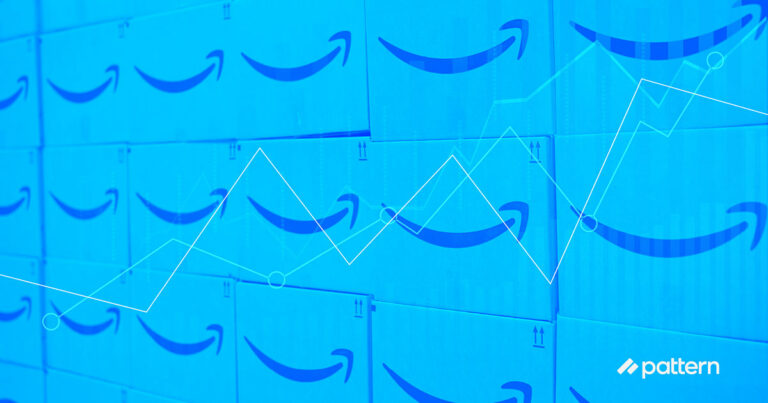How can data become a game-changer for brands seeking to drive traffic to their detail pages or websites? And how can powerful design help brands win at conversion?
I partnered with Enlisted Design CEO Beau Oyler to consider these topics in a Cleveland Research Company webinar on Oct. 13. While Oyler and I couldn’t be a more unlikely duo, combining Pattern’s data and Enlisted’s design has been nothing short of incredible for brands. Below are the main takeaways from our discussion.
Data science, applied
I started Pattern with the idea that we could apply data science principles to moving products. Our primary skill—and where we have the most fun—is using data to help brands understand where they sit in the market and what might be their next opportunity. When we first started, we couldn’t have anticipated the success we’ve seen using this data-driven focus.
Before we get into the specifics of our data-driven models and what they mean for brands, I’d like to first invite executives to consider how they’re staffing their ecommerce teams. While I often hear from CEOs who claim their ecommerce teams aren’t that good, I’m finding that idea is largely flawed. Companies often expect a small team of 3-7 people to manage everything regarding ecommerce, including D2C sites, marketplaces, logistics, price erosion etc. All of these issues are compounded with extending global footprints. The amount of work that this small team needs to figure out is simply untenable.
How to drive traffic

The revenue equation for ecommerce is simple: revenue is generated by multiplying traffic, conversions, and price. For now, I’m going to focus on driving traffic and how to repeat that traffic for customer lifetime value.
Driving traffic The first factor to consider is the macro drivers of traffic—the countries where you can decide to invest your money—and their Gross Merchandise Volume (GMV). The U.S. market is huge, but is dwarfed by China, an essential area to focus on if you want your brand to stay relevant in the next decade. Japan and European markets are also relevant while India and Russia are less so. Examining these macro trends helps brands understand where they can get the most traffic for the least cost.

Keywords and keyword phrases, driven by search, are the most important underlying components of traffic in ecommerce. Pattern’s patent-pending concept, Laddered Destiny, helps analyze how brands fare in the keyword searches most relevant to their product and niche. It also looks at SEO words and bigrams to consider and uses lemmas to ensure brands are using the right root words in their product listings.
Laddered destiny to grow ecommerce Laddered Destiny helps us answer questions like, “Which keywords could you win?” While, for example, a new brand probably couldn’t win the keyword “probiotic” on day 1 on Amazon, it could perhaps win “probiotic for women” or “probiotic for women over 40.” Laddered Destiny helps brands focus on such niche keywords that other brands largely ignore.

We can look at the data Laddered Destiny provides us for Whistle, a brand that creates GPS trackers for pets. We can see which keywords Whistle is currently winning—or showing up in the top 4 search results—in blue. In the case of the screenshot above, Whistle is winning the search term “dog gps tracker.” This keyword phrase is high in both relevance and volume. The yellow dots represent keywords and keyword phrases that Whistle’s similar competitors are winning but Whistle is not.

On the bottom of the model, in the more niche areas, we can see Whistle dominates less in the lower relevance keywords, like, as pictured above, “gps tracker.” Since the right side of the graph focuses on keywords that appear in a high volume of searches, this may be an interesting area to which Whistle can expand.

Laddered Destiny also provides insight into which words and bigrams brands should consider. It compares lemmas to ensure brands are hitting the right root words in its product names and descriptions. Interestingly, the top recommendation for the Whistle product is “dog,” a word which currently does not appear in the product title.
The valuable data Laddered Destiny gives us helps brands know which keywords to focus on, where to budget advertising money, and which products to develop next. We’ve found that the difference between diving into this data at a deep level and ignoring it can be absolutely game-changing, but it’s not magic—in order to be successful, the product itself has to be phenomenal. It needs to be highly relevant along with having great reviews and a good price.

How design comes into play
While my remarks focused on how brands can drive traffic to their products, Oyler focused on how brands can convert this traffic into sales through compelling design.
“The data and analytics can all get us to that moment of introducing the brand or the product to the consumer, but then how do we win to convert that to sales?” Oyler said. “That’s where design becomes our greatest advocate and our greatest conversion tool. That’s when design becomes far more than just aesthetics; it becomes a tool for sales.”

Enlisted Design, which Pattern recently acquired, has seen indisputable success by redesigning, rebranding, and relaunching brands. One such brand is Joyfull Cheese Co., a private label co-manufacturer for Whole Foods invested in a proprietary brand launch by Enlisted and grew sales by 60% in just 18 months.
Perdue Chicken tells a similar story. After Enlisted redesigned its packaging and relaunched the brand, it saw a 7% lift on their multi-billion dollar business. Pet food brand Organix also benefited from Enlisted’s services and now enjoys a 90% share in the organic pet food market.
“We use data to understand the consumer reaction to the current brand, and then use that data and go into testing to create better experiences and better manifestations of a brand’s story,” Oyler said.
The strength of branding and design when applied to data
So, what’s the secret? How can rebranding and new packing completely transform a brand’s presence and sales? Oyler said it comes down to crafting an emotional connection between the consumer and the product. While the function of a product is important, competing companies quickly come to adopt similar feature sets and price points. The DNA of a brand communicated through design, however, is much more difficult to replicate.
“Where we find the most success is where we bring both the function, or the data of what a consumer is searching for, and we add the emotion through the form factor, through the color, material, finish,” Oyler said. “We create products that are not just function based but lifestyle-led, so that when a consumer sees the product, they look at it and think, ‘I want that in my life.’”

Stance, an apparel brand that sells socks and underwear, recently revamped its product and packaging with Enlisted’s help. Oyler said the goal was to create a packaging experience consistent with Stance’s core DNA, which includes sustainability. Enlisted redesigned the sock packaging to use 50% less plastic, 50% less paper, and all soy-based inks.
But do these subtle changes pay off? Absolutely, Oyler argues.
“When you look at pre-launch, post-launch for Stance’s packaging, you see that the consumer adoption is much greater because, yeah, it looks better, but it also communicates better, and it communicates to the core DNA of who stance is,” Oyler said.
Need help incorporating data and design to tell your brand’s unique story? Contact us using the form below to learn more about how Pattern can help your brand beat the competition.



